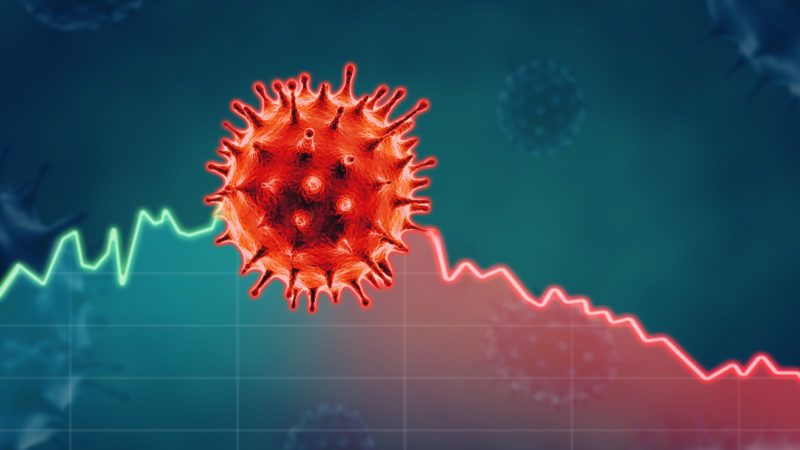There's Good Reason To Think the Omicron Wave Will Peak Soon
Some epidemiologists estimate that the actual number of new infections peaked last week.

Recent COVID-19 trends suggest that the U.S. omicron wave may have peaked in several of the jurisdictions where it was first evident. That would be consistent with what happened in countries such as South Africa and the United Kingdom, which saw huge case surges that lasted less than a month, followed by steep declines. That is shorter than the cycle seen in earlier waves, possibly because omicron is so highly contagious that it quickly infects the people who are most vulnerable to it.
In New York City, where the seven-day average of daily new cases shot up in December and early January, it has leveled off during the last few days. The average for the state peaked this week after a nearly vertical rise that began in mid-December. "It's actually going downward," Gov. Kathy Hochul said on Tuesday. "If you watch the trend line, it looks like we may be cresting over that peak."
Maryland, Massachusetts, and New Jersey have seen similar drops in recent days, and so has the Northeast as a whole, according to the New York Times database. In Boston, David Leonhardt reports in the Times, "the amount of the Covid virus detected in wastewater, which has been a leading indicator of case trends in the past, has plunged by about 40 percent since its peak just after Jan. 1." He also notes that case numbers in Chicago seem to be leveling off. The Washington Post reports that "the Children's Hospital of Philadelphia has seen the rate of teachers testing positive during asymptomatic weekly screening plunge from 25 percent in the week between Christmas and New Year's to 2 percent in recent days."
Nationwide, the surge in reported cases still shows no sign of abating. But these local, statewide, and regional trends are hopeful signs that Anthony Fauci, President Joe Biden's top COVID-19 adviser, was right when he predicted on January 2 that "this thing will peak after a period of a few weeks and turn around."
That expectation was based largely on the experience in South Africa, where omicron was first identified in November. Daily new cases exploded there from late November to mid-December but have since fallen precipitously. The pattern was similar in Malawi, Mozambique, and Namibia, three other countries covered by Biden's omicron-inspired travel restrictions.
In the United Kingdom, newly identified cases have been falling since January 5 after rising dramatically in December. Cases peaked in Greece and Canada around the same time. The numbers have dipped more recently in Denmark and Switzerland.
"It's going to come down as fast as it went up," Ali Mokdad, a professor at the University of Washington's Institute for Health Metrics and Evaluation (IHME), told the Associated Press yesterday. The IHME projects that newly reported cases will peak nationwide at 1.2 million by next Wednesday. But it estimates that the actual number of new infections per day, taking into account people who either are not tested or do not report their results, has already peaked, hitting about 6 million last Thursday.
Even after new infections start to drop, hospitalizations will continue to rise, since there is a lag between diagnosis and the development of serious symptoms. The seven-day average for hospitalizations in the U.S., according to the Times, was about 145,000 yesterday, 5 percent higher than the previous record set in January 2021.
Patients who test positive for COVID-19 after being admitted for other reasons have always accounted for a substantial percentage of those numbers, and their share of the total seems to be higher now than it was during prior waves. Earlier this month, the Times reported that incidental infections represented "roughly 50 to 65 percent of admissions in some New York hospitals."
Even COVID-positive patients without serious symptoms add to the stress on health care systems, since they need to be isolated. The surge will continue to cause serious problems for hospitals during the next few weeks, potentially undermining care for COVID-19 and other medical conditions. "The next few weeks are going to be brutal," University of Toronto epidemiologist Prabhat Jha told the A.P., because "there are so many people being infected that it will spill over into ICUs."
Daily deaths, another lagging indicator, also are apt to keep rising after case numbers decline. But people infected by omicron, which accounted for an estimated 95 percent of newly diagnosed COVID-19 cases as of January 1, are much less likely to experience life-threatening symptoms than people infected by the delta variant, especially if they are vaccinated or have acquired some protection as a result of prior infection. Thanks to increased immunity and omicron's relative mildness, deaths have risen much less dramatically than cases in the United States and other countries, making the current surge far less lethal than last winter's.
"The beginning of the end of the Omicron wave—if it turns out to be real—would be very good news," Leonhardt writes. "It would mean that a milder variant had become the dominant form of Covid but was no longer causing a surge in cases and overwhelming hospitals. It would mean that tens of millions of Americans had built up additional immunity, as a result of an Omicron infection. It would mean that the country would have taken a big step toward a future in which Covid is an endemic disease like the flu, rather than a pandemic that dominates life."


Show Comments (140)